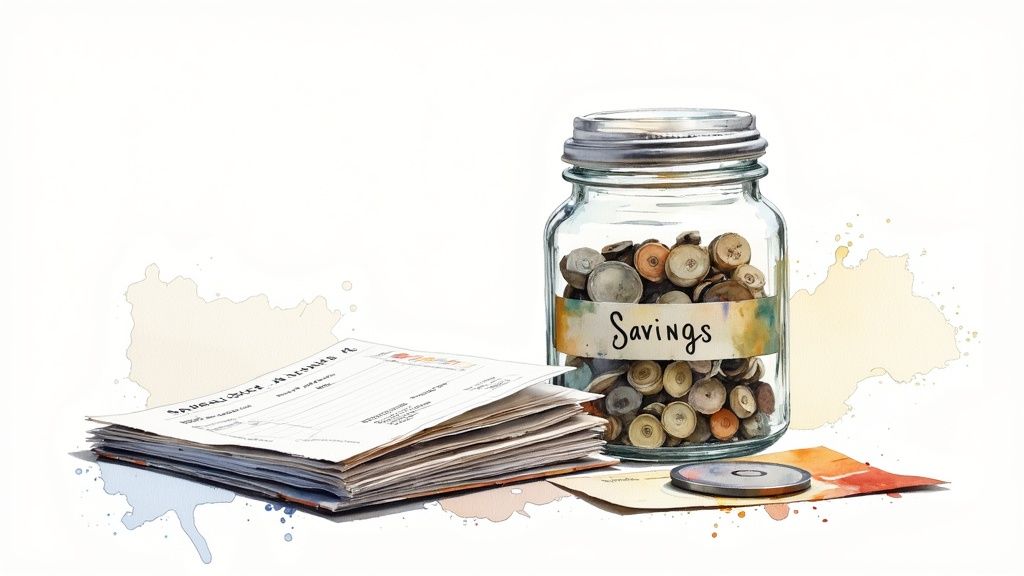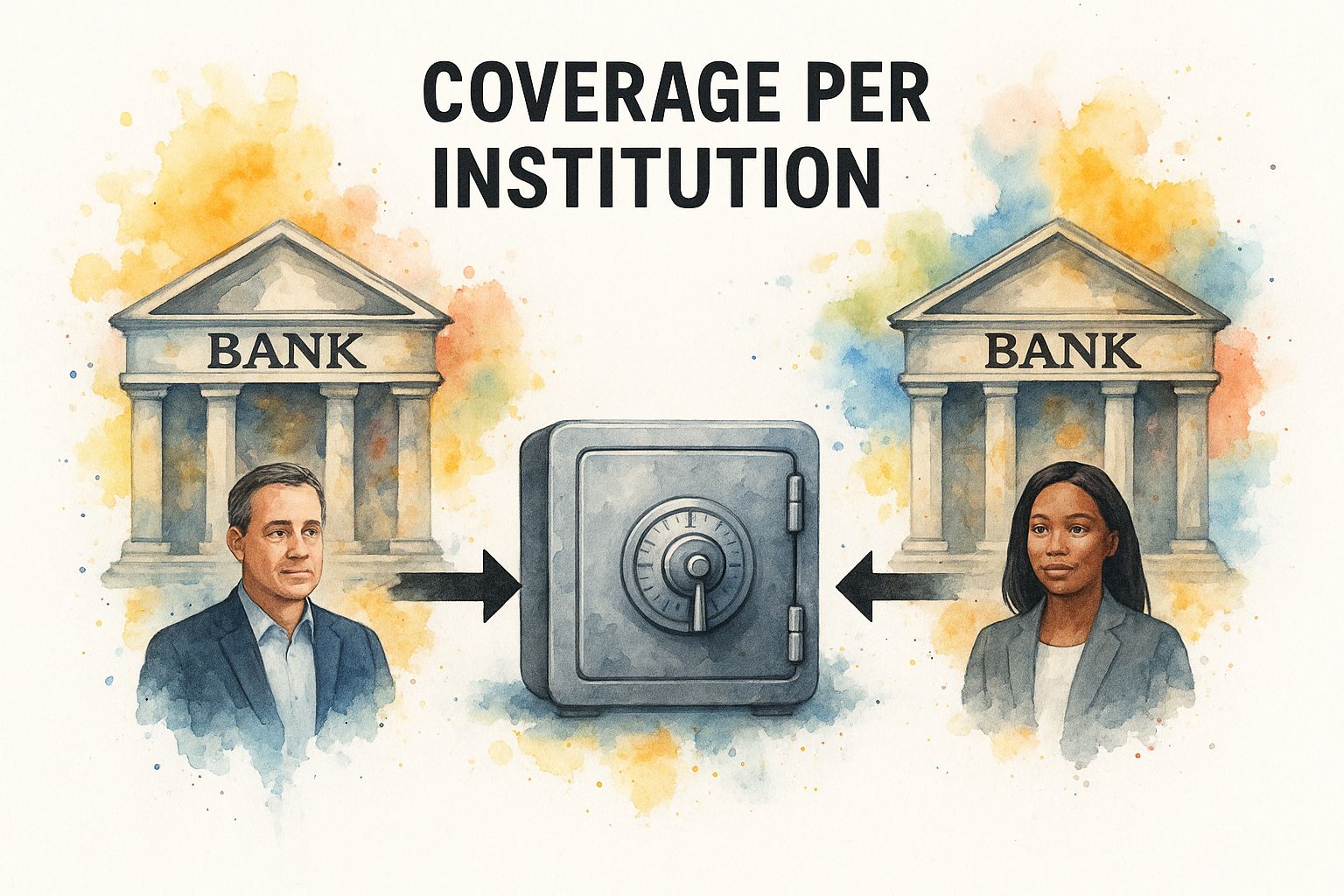Let's get straight to the point: the standard FDIC insurance amount is $250,000 per depositor, for each account ownership category, at each insured bank.
You can think of this as your personal financial safety net, fully backed by the U.S. government. It’s the bedrock of confidence in our banking system.
What Is the Standard FDIC Insurance Limit?

That $250,000 figure is the fundamental rule of deposit insurance. It's specifically designed to protect the cash you've placed in an FDIC-insured bank. If that bank were to fail, this coverage ensures you get your money back, up to that limit.
Here's a simple analogy: Imagine your bank is a ship carrying your money. FDIC insurance is your personal lifeboat. Should that ship go down, your lifeboat is guaranteed to keep your funds—up to $250,000—safe and sound.
The Core Rule Breakdown
The coverage applies to the combined balance of all your deposit accounts at a single bank, as long as they are in the same ownership category. This is a crucial detail.
It covers the most common types of deposit accounts, including:
- Checking Accounts
- Savings Accounts
- Money Market Deposit Accounts (MMDAs)
- Certificates of Deposit (CDs)
So, if you have a checking account with $100,000 and a savings account with $150,000 at the same bank, both under your name alone (a "single" ownership category), your entire $250,000 is fully insured.
To make this crystal clear, here’s a quick-glance table breaking down the core concept.
FDIC Standard Coverage at a Glance
This table simplifies how the three main parts of the rule work together.
| Coverage Type | Standard Limit | Applies To |
|---|---|---|
| Per Depositor | $250,000 | The individual person or entity owning the account. |
| Per Ownership Category | $250,000 | How the account is titled (e.g., single, joint). |
| Per Insured Bank | $250,000 | Each separate FDIC-insured financial institution. |
Understanding these three components is the key to correctly calculating your coverage and ensuring every dollar of your cash savings is protected.
The Story Behind America's Financial Safety Net
 To really understand why deposit insurance matters so much today, you have to rewind the clock. Picture the early 1930s, right in the thick of the Great Depression. Financial panic was rampant. In a terrifying domino effect, over 9,000 banks collapsed, taking the life savings of millions of ordinary Americans down with them.
To really understand why deposit insurance matters so much today, you have to rewind the clock. Picture the early 1930s, right in the thick of the Great Depression. Financial panic was rampant. In a terrifying domino effect, over 9,000 banks collapsed, taking the life savings of millions of ordinary Americans down with them.
Trust in the banking system wasn't just low—it was gone. People frantically pulled their money from any bank they could, even the healthy ones, terrified it would be next. This mass withdrawal, known as a "bank run," created a vicious cycle that only made the economic crisis worse. Something had to be done to stop the bleeding and rebuild confidence from the ground up.
The FDIC wasn't just another government agency; it was a promise. It was a firm commitment from the U.S. government to safeguard its citizens' money and bring stability back to the nation's economy.
That promise was made real with the creation of the Federal Deposit Insurance Corporation (FDIC).
A New Era of Financial Security
Born directly out of this crisis on June 16, 1933, the FDIC had one powerful mission: restore and maintain the public's faith in American banks. It achieved this with a simple, ironclad guarantee—your money would be safe, even if your bank went under.
Initially, the FDIC insurance limit was $2,500 per depositor. That might not sound like much now, but back then it was a huge deal. That single move fully insured over 98% of all bank depositors and marked a massive step forward in consumer protection. You can see how the limits have changed over the decades in this history of FDIC coverage from Bankrate.com.
This isn't just a history lesson. It’s the entire "why" behind the financial peace of mind you have today. The FDIC exists because of the hard lessons learned during one of America's darkest economic chapters. It's the bedrock of stability that prevents that kind of widespread financial disaster from happening again.
Unlocking More Coverage with Ownership Categories
Here's the secret to maximizing your FDIC protection that most people miss: the $250,000 limit isn't just per person, per bank. It’s per person, per bank, per ownership category. This one little detail is your key to insuring well over the standard limit, all within a single institution.
Getting your head around this concept takes you from basic banking knowledge to smart, practical financial strategy. Think of ownership categories as different legal buckets for your money. Each bucket gets its very own $250,000 insurance policy from the FDIC.
By structuring your finances across these different buckets, you can dramatically increase how much of your money is covered. This is exactly how a married couple, for instance, can easily and legally protect $1 million or more at the same bank.
Common FDIC Ownership Categories
The most frequently used categories give you a powerful way to expand your coverage. They include:
- Single Accounts: Owned by one person (like your personal checking or savings account).
- Joint Accounts: Owned by two or more people who have equal rights to withdraw funds.
- Certain Retirement Accounts: This covers Traditional and Roth IRAs, SEP IRAs, and SIMPLE IRAs. These are insured separately from your other non-retirement funds.
- Trust Accounts: Both revocable and irrevocable trusts have their own, more complex rules that can provide significant extra coverage for each beneficiary.
This is a visual breakdown of how your coverage isn't limited to a single account but applies per institution across these different ownership structures.

The key insight here is that the FDIC insures your money based on these distinct legal ownership types—not just the account type, like a checking or savings account.
A Real-World Example
Let’s see this strategy in action with a hypothetical couple, Maria and David, who bank at the same institution.
- Maria's Single Account: She has $250,000 in a savings account under her name only. This is fully insured.
- David's Single Account: He has $250,000 in a money market account just in his name. This is also fully insured.
- Joint Account: Together, they share a joint checking account with a $500,000 balance. Because each co-owner in a joint account is insured up to $250,000, their entire joint balance is covered.
In this scenario, Maria and David have successfully insured a total of $1 million at a single bank. They did this by using just two common ownership categories: single and joint.
This same principle applies to other deposit products, too. If they opened a joint CD, for example, those funds would simply be added to their joint checking account balance when calculating their total joint coverage. You can learn more about how CDs work in our certificate of deposit explained guide.
Mastering ownership categories is how you take control and structure your finances for maximum security.
What FDIC Insurance Protects and What It Doesn't
FDIC insurance is a fantastic safety net for your cash, but it’s crucial to know exactly what it does—and doesn't—cover. Think of it as a specialized shield. It’s designed to protect your deposit accounts, not every financial product you might own, even if you bought them at an FDIC-insured bank.
Getting this distinction right is the first step toward building a truly secure financial foundation. The FDIC’s job is to protect your deposits—the cash you park in a bank for safekeeping. It was never intended to shield you from investment risk, which is the inherent chance that an investment's value could go up or down.
What Is Covered by FDIC Insurance
The FDIC’s protection kicks in for your cash held in specific types of accounts. If your bank fails, the money in these accounts is safe, right up to the legal limit.
The main accounts that fall under this umbrella are the classics:
- Checking Accounts: Your everyday workhorse account for paying bills and making purchases.
- Savings Accounts: The money you’ve set aside for goals, whether it's a new car or an emergency fund.
- Money Market Deposit Accounts (MMDAs): A hybrid account that often acts like a savings account but may come with check-writing features.
- Certificates of Deposit (CDs): These are time deposits where you agree to leave your money untouched for a set period in exchange for a fixed interest rate. We cover why these are considered so secure in our guide on whether CDs are safe investments.
Basically, if it’s a cash deposit, it’s covered. The FDIC also insures cashier's checks and money orders issued by the bank itself.
The core mission of FDIC insurance is simple: protect depositors from losing their money if a bank goes under. It is not there to protect investors from the ups and downs of the market or from making a bad investment call.
What Is Not Covered by FDIC Insurance
This is where things can get a bit blurry for many people. Any financial product that carries market risk—meaning it has the potential for both gains and losses—falls outside the FDIC's protective reach.
The FDIC does not cover:
- Stocks and Bonds: These are investments, not deposits. You're buying a piece of a company or lending money to a government or corporation.
- Mutual Funds: Even if you buy them from a financial advisor at your bank branch, these are still investment products.
- Annuities: These are insurance contracts, typically for retirement income, and are not bank deposits.
- Life Insurance Policies: Like annuities, these are insurance products, not cash deposits.
- Safe Deposit Box Contents: This is a big one. The FDIC insures your deposits, not the physical items you store at the bank. Any cash, jewelry, or important documents in a safe deposit box are not insured by the FDIC.
To make it crystal clear, here’s a simple table breaking down what’s protected and what isn’t.
What's Insured vs. Not Insured by the FDIC
| Product Type | Covered by FDIC? | Example |
|---|---|---|
| Checking Account | Yes | Your primary account for daily spending. |
| Savings Account | Yes | A standard account for setting money aside. |
| Certificate of Deposit (CD) | Yes | A $10,000, 5-year CD held at an insured bank. |
| Money Market Deposit Account (MMDA) | Yes | A high-yield savings/checking hybrid account. |
| Stock Investments | No | Shares of Apple (AAPL) bought via a brokerage. |
| Mutual Funds | No | An S&P 500 index fund, even if sold by a bank. |
| Annuities | No | An insurance contract that provides retirement income. |
| Safe Deposit Box Contents | No | Jewelry, legal documents, or cash stored in a box. |
Knowing exactly what’s protected helps you see your true FDIC coverage at a glance and identify where the risks are in your overall financial picture.
How to Verify Your FDIC Coverage in Minutes
Knowing the theory is one thing, but putting it into practice is what really builds financial confidence. Instead of wondering if your money is fully protected, you can get a definitive answer in just a few minutes.
The FDIC provides its own free, official tool for this exact purpose. It's called the Electronic Deposit Insurance Estimator, or EDIE for short. Think of it as a confidential check-up for your deposits. It gives you a precise report showing how your coverage stacks up based on the way you've structured your accounts at a specific bank.
No more guesswork.
Using the FDIC's EDIE Calculator
The process is refreshingly simple and completely anonymous. You won't be asked for your name, social security number, or any specific account numbers.
To get started, you just need to pull together a few key details for one bank:
- The types of accounts you have (e.g., checking, savings, CDs, IRAs).
- The current balance in each of those accounts.
- The legal ownership category for each account (single, joint, trust, etc.).
Let's walk through a real-world scenario. Imagine a couple, Alex and Ben. They bank together and have a total of $800,000 at their local institution. They need to know how much of it is actually insured.
Using EDIE isn't just about getting a number; it’s about getting certainty. The tool empowers you to see exactly how the FDIC applies its rules to your real-life financial situation, taking all the guesswork out of the equation.
Here’s a breakdown of their accounts:
- Alex's Individual Account: A checking account holding $100,000.
- Ben's Individual Account: A savings account with $250,000.
- Joint Account: A money market account they own together with $450,000.
When they enter this information into EDIE, the FDIC's online calculator, the tool analyzes each ownership category one by one.
The results are crystal clear. Alex’s $100,000 individual account is fully insured. Ben’s $250,000 savings account is also fully insured.
But the joint account is where things get interesting. EDIE shows that of the $450,000 balance, only $400,000 is insured—$250,000 for Alex's share and only $150,000 of Ben's share, leaving $50,000 uninsured. This simple check confirms their total insured amount is $750,000, giving them the clarity they need to move the unprotected funds and secure full coverage.
Answering Your Top FDIC Questions
Even after you've got the rules down, real-world questions always pop up. Let's walk through some of the most common things people worry about when it comes to FDIC insurance.
The biggest fear is often, "What happens if I have too much money in the bank when it fails?" Say you have $300,000 in a single account. If that bank goes under, the FDIC will promptly pay you the insured limit of $250,000.
What about the other $50,000? That amount is considered an uninsured deposit. You don’t automatically lose it, but getting it back isn't guaranteed. You essentially become a creditor, and you might receive some or all of it back as the FDIC sells off the bank's assets. This process can be slow, though, and a full recovery isn't a sure thing.
What About Payment Apps Like PayPal and Venmo?
This is a huge question now that so much of our money moves digitally. The short answer: it depends.
Money sitting directly in your PayPal or Venmo balance is typically not FDIC insured. That's because these companies are not banks; they're money transmitters.
However, many of these apps now offer "pass-through" insurance. If your funds are linked to certain features—like a debit card they issue or a savings-like function—the app may place your money in a partner bank. In that case, it gets FDIC coverage through that partner bank. You have to read the fine print for your specific app to be certain.
The most important thing to remember is this: if your money isn't sitting in a deposit account at an FDIC-insured bank, it's probably not protected by the FDIC. This one rule cuts through the confusion for almost any financial product.
Are Banks and Credit Unions the Same?
They look and feel similar, but they're insured by different federal agencies. Banks are insured by the FDIC. Credit unions, which are non-profit and member-owned, are insured by the National Credit Union Administration (NCUA).
The good news is that the protection is identical. The NCUA's National Credit Union Share Insurance Fund (NCUSIF) also insures your deposits up to $250,000 per shareholder, per ownership category, per credit union.
So, whether you're a bank customer or a credit union member, your savings have the same strong federal backing.
Ready to put your insured savings to work? The Certificate-of-Deposit Calculator can help you project earnings on your fixed-term deposits with total confidence. Plan your financial future by seeing how different rates and terms can boost your returns on safe, insured investments.